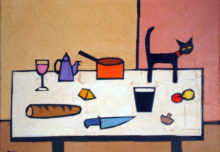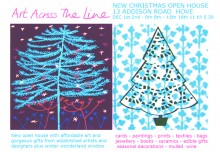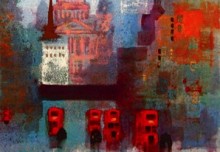ARTISTIC LICENCE. A skill or a creative act?
Artistic License (also known as Poetic License or Dramatic License).
Examples would be in a written piece like a novel where the facts of history are altered for the story line, such as introducing a meeting of the fictional hero and a real famous person.
Or, in a picture where details are left out like wrinkles or blemishes in a portrait. Or where the colour is all wrong.
![BLACK CAB by Colin Ruffell [example of artistic licence?]](https://www.artpublish.com/wp-content/apimages/2013/10/Black-Cab-570.jpg)
‘BLACK CAB’ by Colin Ruffell OAR100153 [example of artistic licence?]
But of course I accept that I do use the wrong colour. I try to paint what it feels like rather than what it looks like. I can see what it looks like by comparing a photograph with the same view in my minds eye and then in one of my paintings. The photograph is grey while my picture is brighter and more colourful.
Is ‘artistic licence’ a good thing?
The problem is whether artistic licence [deliberate distortion] is legitimate. Is it a good thing or a bad thing?
Wikipedia describes ‘artistic licence’ as a colloquial term used to denote a deliberate distortion of fact by artists and writers.
So artistic licence might be a fair description of the deliberate talented use of the super special gifts and insights that artists and writers have when they create their art. Or is it?
Artistic licence sometimes provokes controversy by offending those who resent the reinterpretation of facts, cherished beliefs, or previous works.
I have also heard it said that artistic license is just an excuse used by artists or writers when they get found out making mistakes.
What is art?
Basically it all boils down to the different ideas that people have about what written and visual art is.
The usual question is…”is art A, B, C, or D?”
- A. a learned and practiced skill,
- B. a creative act,
- C. a delusion,
- D. a conspiracy
Let us put aside the delusion or conspiracy discussion for another time. [Rubs hands with anticipation and glee.] Instead we can consider the difference between the explanations A and B claiming ‘skill’ and ‘creative act’.
And also lets focus on visual art rather than the written word.
If visual art-making is a skill then some deliberate distortion might be deployed, but accuracy would be more highly valued. Artistic licence would be a weakness.
If art-making is a creative act then accuracy is not the criteria. Instead the viewer yearns for emotive excitement and pleasure. Deliberate distortion will be part of the language that sorts out the difference between photographic representation and an artistic view.
Example.
So here I will try to describe a little bit about how I use my ‘artistic license’ when I am making my visual art. Maybe that will help.
Over the years, I have found that the picture looks better if it has strong rich colour.
It feels as though the camera has a grey filter over the scene. When I look at the subject that I am going to paint I can see more colours than the camera lens records.
I guess my eyes are better than a camera. I guess that our human eyes can all work the same way and that we all see and process more colour and tone in our super visual cortex than a camera can.
Yes that’s it! We humans can see and process a visual experience. It is the processing in our visual cortex that lets us see and feel all the extra colours that a camera cannot record.
But, do I overdo the effect? Do I deliberately distort the colours to create extra emotional reaction? Yes I do. I overdo the richness to try to capture that feeling of excitement and interest that I felt when I set out to paint the view.
A distant object might become fainter, and the darks darker, as I exaggerate tonal range from dark to light.
I can do the same with some shapes. A tall building might become taller. A complex shape might become simpler. In fact I might omit buildings so that the scenic focus is on the centers of interest.
Conclusion.
So I use my ‘artistic license’ to create an effect that I hope others will find enjoyable.
I admit using my ‘artistic license’ and it seems that that my artwork is an example of the ‘creative act’ school of thought.
But I guess that over the last seventy years painting pictures I have probably picked up a few skills as well.
I hope that clears it all up.
PS. I realise that have randomly used the English spelling and the US spelling for ‘license’ and ‘licence’ because I don’t know who is going to be reading this. So please don’t give me a hard time. Oh yes, realise and realize. And colour and color. It is a long list.
***LATEST NEWS***
Here at ArtPublish.com we have set up a couple of new groups.
The first group is for Art Lovers and Art Collectors who are interested in our art-work. For members of the group we will be offering discounts, special previews, advance news about exhibitions and new releases, private view invitations, and other things.
The second group is aimed at fine-art professionals. The members are artists, art dealers, publishers, galleries, art teachers, and art investors. Here we share our own 150 years experience as full-time fine-art professionals, and invite others to join in discussions, etc.
And of course some of our readers want to be in both groups.
This is how you can join either group, or both groups.
Please click on the link below that suits you best for more info
C. “I am interested in both please send me all the information.”




